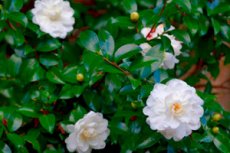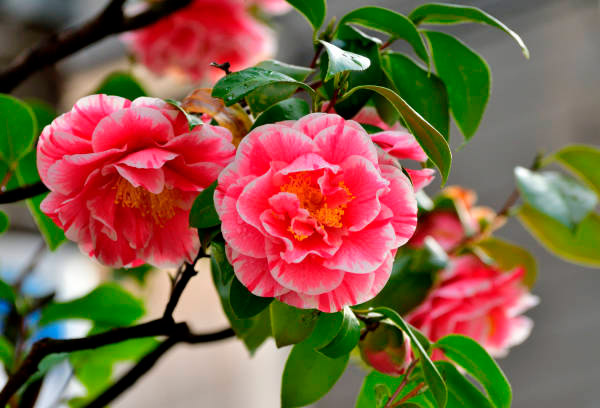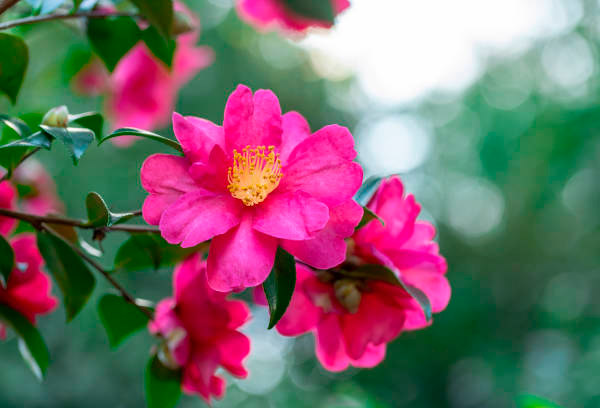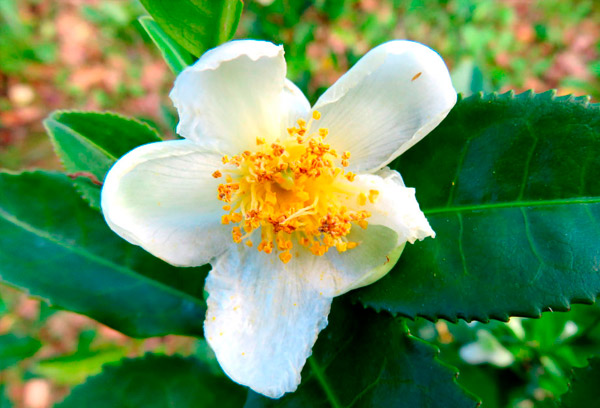New publications
Plants
Camellia
Last reviewed: 29.06.2025

Camellia (camellia) – a genus of perennial plants in the tea family (theaceae), which includes about 100-250 species, primarily distributed in east and southeast asia. These plants are known for their beautiful flowers, which range in color from white to red and pink. Camellia is an evergreen shrub or tree with smooth leathery leaves and numerous flowers, either solitary or in clusters. The popularity of camellia is not only due to its ornamental qualities but also its use in culture, such as in the production of tea.
Etymology of the name
The name "camellia" comes from the name of the czech priest and botanist georg kamel, who was a missionary in japan in the 17th century. Kamel was actively involved in studying the flora of east asia and introduced several plant species to europe, including camellia. Thus, the latin name is a tribute to his scientific work.
Life form
Camellia can exist in the form of a shrub or a small tree, depending on the growing conditions and variety. Shrubby species tend to have a more compact shape, often not exceeding 2-3 meters in height, while trees can reach up to 10 meters in nature, with a more spreading and branching crown. This adaptation to different climatic conditions allows camellia to easily adjust to various landscapes.
In temperate climates and with proper care, camellia often grows as an ornamental plant in gardens and parks, reaching significant sizes, while in mountainous regions it can be a low shrub. Hybrid varieties, which retain compact sizes, are especially valued, making them ideal for cultivation in domestic settings.
Family
Camellia belongs to the family theaceae, which includes about 50 genera and more than 1,000 plant species. This family is widespread in tropical and subtropical regions of asia, africa, and australia. Representatives of this family, such as camellia and tea, have significant economic importance. The tea camellia (camellia sinensis), part of this family, is known for the production of one of the most popular beverages in the world – tea.
All plants in the theaceae family share similar botanical features, such as simple, smooth leaves and bright flowers, often with three or five petals. Camellias, in particular, attract attention due to their abundant flowering and can be grown for ornamental purposes both in greenhouses and in open ground.
Botanical characteristics
Camellias are characterized by large, glossy leaves, which, depending on the variety, can be dark green or light green. The leaves have a pronounced leathery texture, which helps the plant retain moisture in hot conditions. The flowers of camellia are diverse, and they can be solitary or collected in small clusters. The camellia flower has a multilayered structure and consists of numerous petals, which can be smooth or slightly curled.
Camellia is also a plant with remarkable resistance to diseases and pests, which makes it quite popular in ornamental gardening. However, some species may suffer from aphid attacks or fungal diseases if growing conditions are not ideal.

Camellia japonica
Chemical composition
The leaves of camellia, like most plants in the theaceae family, contain caffeine, theophylline, and theobromine, which have stimulating properties. These substances explain the use of tea camellia in the production of beverages such as green and black tea. The leaves also contain catechins – powerful antioxidants that help combat inflammation and strengthen blood vessels. Additionally, camellias have a high concentration of vitamins a and c, as well as trace elements like potassium and magnesium.
Some species of camellia, particularly those used in the cosmetic industry, contain oils that are applied for moisturizing and rejuvenating the skin, as well as for strengthening hair.
Origin
The native home of camellias is east asia, particularly china, japan, and korea. These plants grow in mountainous areas where a moderately warm climate with sufficient rainfall is observed. Camellia has been known in china for thousands of years, where it was used not only for ornamental purposes but also as a medicinal plant.
In europe, camellia appeared in the 18th century after the first specimens were brought from china. They quickly gained popularity as ornamental plants and became an important element in gardens and parks in aristocratic circles, as well as being widely used in botanical gardens.
Ease of growing
Camellia is a relatively easy plant to care for, but it does require certain attention and care for successful growth. The most important factors for growing camellia are a stable level of humidity, moderate temperature, and protection from direct sunlight. By maintaining these conditions, camellia will thrive and reward with its blooming.
In indoor settings, camellias should be grown in pots with quality drainage to avoid waterlogging in the roots. Watering should be regular but without excessive moisture, which is especially important during winter when the plants go into a dormant state.
Species, varieties
There are many species and varieties of camellia, the most well-known of which are japanese camellia (camellia japonica), chinese camellia (camellia sinensis), and sasanqua camellia (camellia sasanqua). These species differ in the shape and size of their flowers, as well as in blooming periods. Japanese camellia, for example, often has large and bright flowers, while sasanqua camellia is known for its more modest and often fragrant coloring.

Camellia sasanqua
In addition, there are many hybrid varieties of camellia, often used in ornamental gardening. These varieties can be either low-growing or tall, with diverse flower and leaf colors.

Camellia sinensis
Size
The size of camellia depends on the specific species and growing conditions. In nature, camellias can reach up to 10 meters in height, but when grown in pots or gardens, they often do not exceed 2-3 meters in height. The size of the flowers also varies by variety: some species have flowers up to 12 cm in diameter, while others have smaller flowers.
When grown in containers, camellia typically remains compact and does not exceed a height of 1-1.5 meters. This makes it an ideal plant for decorating interiors and small gardens.
Growth intensity
Camellia grows relatively slowly, especially in the first few years of its life. Typically, plants reach their maximum height after 4-5 years, and the first flowers may appear 2-3 years after planting. The growth of camellia depends on climate, soil conditions, and care. In warmer and more humid conditions, camellia may grow faster, but its development still remains relatively slow.
A slight decrease in growth intensity is also characteristic during the winter period, when the plant is in a dormant state and does not require active growth.
Lifespan
Camellias can live for decades, and some varieties are capable of maintaining their ornamental appeal throughout their entire life cycle. In natural conditions, camellia can live for more than 100 years, although in domestic settings, the lifespan may be shorter depending on care conditions. It is important to note that with proper care, camellia can delight its owner with stable blooming for many years.
The lifespan of camellia is also influenced by its location – in gardens and greenhouses with optimal conditions, it can live much longer than in pots, where root problems or soil dehydration may occur.
Temperature
For normal growth, camellia requires a moderate temperature regime. In winter, it needs cool conditions, with a temperature of around 10-15°c. In warmer conditions, the plant may start losing its leaves and cease flowering. Summer temperatures should not exceed 25-30°c, otherwise, camellia may experience stress, especially if the air is too dry.
It is important to avoid sudden temperature fluctuations, especially in the cold season, when the plant may be exposed to frost.
Humidity
Camellia prefers high air humidity, especially in winter. To achieve this, the plant should be regularly sprayed or placed near moisture sources, such as humidifiers or damp stones. Dry air can cause wilting and yellowing of leaves, as well as slow down the plant's growth.
Additionally, camellia requires well-drained soil to avoid water stagnation, which can lead to root rot.
Lighting and room placement
Camellia requires bright but diffused light. Direct sunlight can cause leaf and flower burns, so it is best to place camellia in areas with soft but sufficiently bright lighting. Western and eastern windows are suitable for this purpose.
Indoors, camellia can grow well if a stable temperature regime and sufficient lighting are provided, especially during the winter period when daylight hours become shorter.
Soil and substrate
The proper choice of soil is one of the key factors for the successful growth of camellias. The soil mixture should be light, breathable, and have good drainage capabilities. The ideal soil for camellias consists of equal proportions of peat, sand, and perlite. Peat provides the necessary acidic environment and moisture retention, sand improves structure and drainage, while perlite prevents soil compaction and enhances root aeration. It is important that the mixture is not too dense, as this could lead to water stagnation and root rot.
The soil ph for camellias should be slightly acidic, with a range from 5.5 to 6.5. This is crucial, as camellias do not tolerate alkaline or highly acidic soils. To improve drainage, it is recommended to add small stones or expanded clay to the soil. It is also important to ensure that the soil remains slightly moist at all times, but without excess water, which is achieved with proper drainage.
Watering (summer and winter)
In summer, camellia watering should be regular and abundant, especially during the hot months. The soil should always be slightly moist but not waterlogged. It is important to ensure that water does not stagnate in the saucer, as this can lead to root rot. During the summer, camellias need more water as they are actively growing and developing. Watering should only occur when the top layer of soil begins to dry slightly.
In winter, watering is significantly reduced, as camellias slow down their growth during this time. During the cold season, watering should be less frequent, but it is crucial not to allow the soil to dry out completely. The camellia should remain slightly moist, but its roots should not be submerged in water. This requires careful attention to maintain the balance between moisture and drainage, especially in lower temperatures.
Fertilization and feeding
Camellias require regular feeding, especially during their active growth and flowering periods. For fertilizing, it is advisable to use fertilizers that contain a balanced mix of nitrogen, phosphorus, and potassium, preferably in liquid form. Fertilizers for camellias are often sold in specialized stores and are specifically designed for plants with acidic soil. It is important to follow the recommended dosage, as excess fertilizer can lead to root burns or growth delays.
Feeding should be done from spring to autumn, and in winter, when the camellia is in its dormant period, no fertilizers should be applied. Fertilizer should be applied every 4-6 weeks starting in spring, using liquid feed diluted in water for watering. Organic fertilizers such as compost or well-rotted manure can also be used to provide the plant with necessary microelements.
Flowering
Flowering is the main decorative feature of the camellia and occurs depending on the variety and growing conditions. Camellias generally bloom from late autumn to early spring. The flowers can be solitary or grouped in small clusters and vary in color from white and pink to deep red. It is important to provide the plant with sufficient light and a stable temperature to stimulate flowering, as this can be influenced by lighting conditions and temperature fluctuations.
Some varieties of camellias begin to flower in the second or third year after planting, but for full flowering, camellias require several years to establish a strong root system. It is important to remember that a camellia will not flower if it does not receive enough light or if the room temperature is too high or low. Additionally, stress caused by improper care or transplanting can negatively affect the flowering process.
Propagation
Camellia propagation can be done in several ways, with the most popular method being by cuttings. Healthy camellia shoots are selected and cut from the plant in early summer. Cuttings of 10-15 cm are rooted in a mixture of peat and sand at a temperature of 20-25°c, maintaining high humidity. Rooting can take from 4 to 6 weeks, and the cuttings should be protected from direct sunlight.
Camellia can also be propagated from seeds, but this process is more complicated and takes longer. Seeds germinate over several weeks, but for successful germination, it is important to maintain the right temperature and humidity. Seedlings grown from seeds develop slowly and may not bloom for several years, which makes this method less popular among gardeners.
Seasonal features
Camellia is a plant with distinct seasonal requirements. In spring and summer, when the plant is actively growing, it needs more frequent watering and fertilization, as well as bright, but diffused light. In autumn, the camellia begins to prepare for the winter period, its growth slows down, and at this point, watering should be reduced, and the amount of fertilization cut back. It is also important to provide the camellia with comfortable conditions for wintering, avoiding temperature fluctuations and excessive sunlight.
In winter, the camellia enters a dormant state, and during this time, it does not require intensive care. However, it is important to maintain stable humidity levels and control the temperature to prevent root damage from cold. This period of dormancy allows the plant to gather strength for future flowering, which typically begins with the arrival of spring.
Care features
Caring for a camellia requires regular attention to its condition to keep the plant healthy. Key aspects of care include proper watering, choosing suitable soil, maintaining moderate temperatures, and protecting it from direct sunlight. Camellias also do not tolerate frequent repotting, so they should only be transplanted when necessary, such as when the roots fill the pot. During active growth, the plant requires regular feeding.
It is also important to monitor the condition of the leaves and flowers. Camellias can suffer from a lack of light if their placement is not optimal. In such cases, flowering may be reduced or fail entirely. Regularly cleaning the leaves from dust will help the plant receive more light and perform photosynthesis effectively.
Indoor care
When caring for a camellia indoors, several key factors should be observed. First, the plant should be placed in locations with soft, diffused light, such as on eastern or western windows. Camellias do not like direct sunlight, which can cause leaf burns. Second, maintaining high humidity is important for successful growth. In winter, air humidifiers or misting can be used to prevent the plant from drying out.
It is also necessary to ensure that the roots do not remain in water, as this can lead to root rot. Regularly check the soil condition, especially during the winter months, and avoid overwatering. Camellias do not like water stagnation, so good drainage in the pot is essential. It is also important to avoid sudden temperature fluctuations, especially during the winter months.
Repotting
When repotting a camellia, the size and material of the pot should be taken into account. The pot should be slightly larger than the previous one but not too large to avoid water stagnation. It is best to choose plastic or ceramic pots that provide good drainage, as camellias do not tolerate stagnant water in the soil. Repotting should be done at the end of winter or early spring, before the active growth period begins, while the plant is still dormant.
It is important to repot the camellia only when necessary, as frequent repotting can stress the plant. If the roots start to overcrowd the pot or if the soil has lost its nutrient value, repotting will be necessary. After repotting, it is crucial to maintain stable humidity for the plant and avoid direct sunlight to help it adapt to the new conditions.
Pruning and shaping the crown
Pruning camellias is done to maintain their shape and stimulate new growth. This is especially important for shrub varieties, as they can have an excessively sprawling shape. It is recommended to prune old and damaged branches in spring, after the plant stops blooming. Pruning helps the plant grow more compactly and promotes better flowering in the next season.
Shaping the camellia’s crown involves removing unnecessary branches that do not contribute to the overall appearance of the plant. Pruning should be done with sharp tools to avoid damaging the bark and other parts of the plant.
Possible problems and solutions
Camellias may encounter several diseases, the most common being fungal infections such as powdery mildew and gray mold. These diseases typically arise from excessive moisture or improper care conditions, such as poor ventilation or water stagnation in the pot. To prevent these problems, it is important to monitor the soil condition and ensure good drainage for the camellia. Also, avoid overwatering and high humidity, especially during the cold season. If a disease is already present, the plant should be treated immediately with a fungicide.
A deficiency of nutrients can lead to the deterioration of the camellia’s condition. Signs of nitrogen deficiency appear as yellowing of the leaves, while phosphorus deficiency causes slowed growth and reduced flowering. To solve these problems, balanced fertilizers with micronutrients and nitrogen should be applied regularly. However, it is important not to over-saturate the soil, as excess fertilizers can cause root burns and delayed growth. Checking the soil condition and regular feeding will help avoid such unpleasant situations.
Pests
The main pests of camellias are aphids, spider mites, and scale insects. Aphids can cause deformation of the leaves and shoots, while spider mites weaken the plant, causing yellowing and dryness of the leaves. Scale insects, in turn, affect the stems by sucking sap from the plant. Pest prevention involves regular inspection of the plant's condition, maintaining optimal humidity, and using insecticides if pests are noticed. Special treatments like acaricides and insecticides can be used to combat aphids and spider mites.
Chemical protection against pests should be used when necessary. The appropriate treatment should be selected based on the specific type of pest, and the dosage should be correct to avoid harm to the plant. It is important to remember that treatment should be done at the right time of year to avoid damaging the camellia, especially during the blooming period. Regular preventive treatments will help keep the plant healthy and protected from external threats.
Air purification
Like many other houseplants, camellia has the ability to purify the air by absorbing harmful substances such as formaldehyde and ammonia. Plants with large leaves actively participate in photosynthesis and moisture evaporation processes, which helps improve air quality in the room. Camellia can also raise the humidity level in the room, which has a positive effect on human health, especially during winter when the air becomes dry due to heating.
One way to use camellia for air purification is to create a composition of several plants in the room. Such plant groups not only decorate the interior but also significantly improve the microclimate in the home by circulating clean air. This is especially beneficial for people suffering from respiratory diseases or allergies.
Safety
Camellia is not toxic to humans or pets. However, if a large amount of the plant is ingested, such as by eating, mild symptoms of poisoning may occur, such as stomach upset or vomiting. This is very rare, but it is worth remembering that it is best to avoid eating any part of the plant, especially by children or animals. Camellia is considered safe for use in homes with children and pets, but caution should still be exercised.
Allergic reactions to camellia are also unlikely, but possible in people with plant hypersensitivity. The most likely manifestation is an allergy to pollen, which can cause conjunctivitis or respiratory symptoms such as coughing or sneezing. In such cases, it is recommended to limit contact with the plant, especially during flowering.
Wintering
Wintering camellia requires special attention, as the plant enters a dormant state during this period. It is important to provide the right temperature — around 10-15°c, with minimal light and dry conditions. Watering during this time should be minimal to avoid excess moisture, which can lead to root rot. Wintering the camellia in warmer conditions can lead to plant exhaustion, disrupt its natural cycle, and reduce flowering in the future.
Preparing for spring involves gradually increasing light and temperature levels, as well as resuming watering and feeding. When spring arrives, camellia can be moved to a brighter location and watering frequency increased. This helps the plant restore activity and prepare for the next growth and flowering cycle.
Beneficial properties
Camellia, especially its tea varieties, has many beneficial properties. The leaves of tea camellia (camellia sinensis) contain caffeine, catechins, and polyphenols, which have a stimulating effect on the central nervous system, increasing mental activity and endurance. Tea made from these leaves helps improve metabolism, strengthen the immune system, and reduce cholesterol levels in the blood. Camellia is also known for its antioxidant properties, which help slow down aging processes and reduce the risk of chronic diseases.
Additionally, camellia is used to improve the condition of the skin and hair. Oils extracted from its leaves are actively used in the cosmetic industry to create moisturizing and anti-aging products. Camellia also has a calming effect on the skin, reduces inflammation, and helps with eczema and dermatitis.
Use in traditional medicine or folk recipes
In traditional medicine, camellia is used to prepare infusions and decoctions that have a positive effect on health. Tea made from tea camellia leaves is known as a remedy for improving metabolism, normalizing heart and vascular function, and also as an antioxidant. In chinese and japanese medicine, camellia extracts are used to treat colds, boost immunity, and improve digestion. Camellia tea is also used to relieve fatigue and stress.
Camellia oils, which have antiseptic and moisturizing properties, are also used in folk remedies. The oil helps with skin diseases such as eczema and psoriasis, and is also used for hair care. Some folk remedies based on camellia are recommended to improve skin condition and reduce inflammation.
Use in landscaping
Camellia is often used in landscaping due to its decorative qualities and durability. This shrub with bright flowers is perfect for creating hedges, flower beds, and borders. Camellia looks great in solitary plantings, as well as in group compositions, where it becomes a vibrant accent. Thanks to its resilience to various weather conditions, camellia adapts well to temperate climates, making it a popular choice for gardens and parks.
Camellia is also used in vertical gardens and hanging compositions. It can be grown in containers suspended on walls or in garden structures, allowing the creation of striking green walls and decorating terraces and balconies. Camellia in such compositions will delight the eye with its beautiful flowers and create a cozy atmosphere and clean air.
Compatibility with other plants
Camellia pairs well with other plants that require similar growing conditions. For example, it will look wonderful in combination with azaleas, rhododendrons, and heathers, which also prefer acidic soil and a moist climate. It is important to note that camellia does not like to be near plants that compete for light or moisture, such as large shrubs with aggressive root systems.
Moreover, camellia pairs well in compositions with conifers such as cypresses and thujas. This combination is especially suitable for creating decorative groups in the garden, as conifers provide winter interest while camellia adds vibrant color in spring and autumn.
Conclusion
Camellia is a wonderful ornamental plant that not only decorates interiors and gardens but also provides health benefits. Its use in traditional medicine and cosmetics confirms its versatility and value. Camellia requires attentive care and optimal growing conditions, but cultivating it indoors and in gardens can be an extremely satisfying and successful experience.
Furthermore, camellia holds great significance in landscaping and can be used to create beautiful composition groups. With its help, any garden or interior can be transformed, making it more picturesque and cozy.
